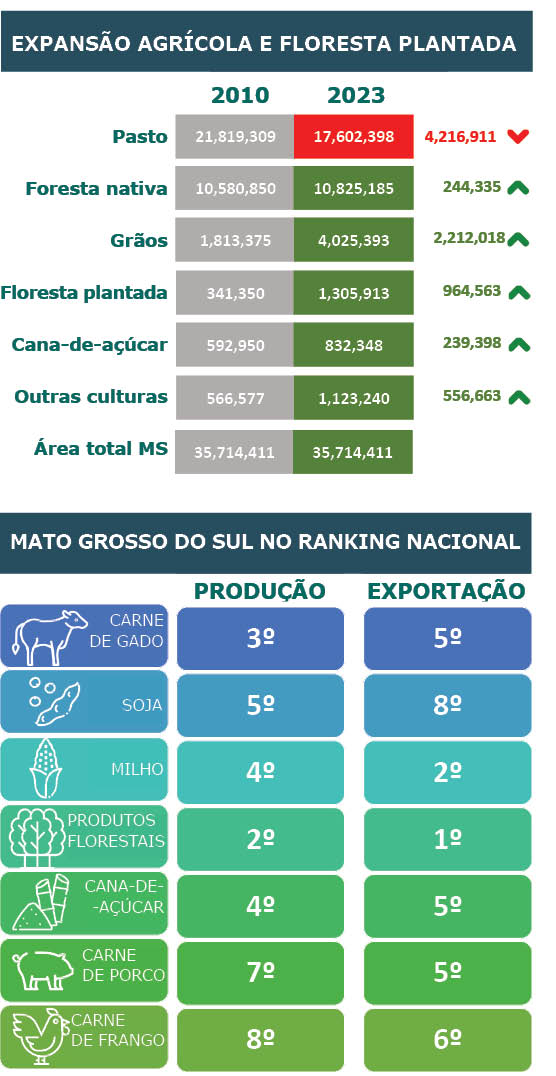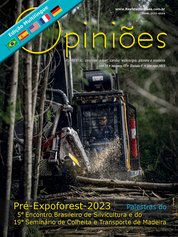Luis Calvo Ramires Jr.
Diretor Executivo da Ramires Reflortec e Vice-presidente da Reflore
OpCP72
Será que a produtividade potencial máxima já não foi atingida?
Todos sabemos que as florestas plantadas ou plantios florestais têm desempenhado um papel fundamental na economia e no meio ambiente do Brasil. Ao longo das últimas décadas, houve um aumento significativo na produção de florestas plantadas no país, impulsionado principalmente pelo setor de papel e celulose. No entanto, apesar dos avanços, existem desafios importantes que precisam ser enfrentados para garantir a sustentabilidade e a eficiência dessa atividade.
Além dos desafios nos aspectos que abrangem a produção diretamente, como o aumento de custos dos insumos, a escassez da mão de obra e a infraestrutura logística, temos que focar para dois temas muito importantes que afetam diretamente o resultado do retorno do negócio florestal: a Produtividade florestal, um tema muito debatido e estudado, e outro pouco questionado, mas um insumo muito importante para a floresta, que é a Terra, um insumo cada vez mais escasso e caro à medida que os projetos florestais crescem.
A produtividade das florestas plantadas no Brasil foi um fator chave para impulsionar o setor florestal em comparação ao resto do mundo. A produtividade média das plantações de eucalipto alcançou cerca de 35 metros cúbicos por hectare ao ano e pode chegar até 40 metros cúbicos por hectare ano. Esses números refletem os avanços em termos de melhorias genéticas, investimentos em pesquisa e desenvolvimento.
A busca contínua por maior produtividade é essencial para atender à crescente demanda por produtos florestais, para garantir a competitividade do setor e promover a sustentabilidade a longo prazo das florestas plantadas no Brasil. Porém, a pergunta importante a ser feita é: será que a produtividade potencial máxima já não foi atingida?
Minha resposta para essa pergunta tende muito para o sim, e hoje os ganhos prováveis ainda podem ser em uma escala de ganhos pequena com melhorias na silvicultura e desenvolvimento de novos materiais clonais. Os novos materiais não devem somente focar a produtividade crescente, mas a variabilidade para que não haja uma estagnação ou até um decréscimo nas produtividades médias.
Com os ganhos de produtividades limitados a um crescimento atingindo seu potencial próximo do máximo, o custo relacionado à Terra se torna uma peça-chave na viabilidade econômica de novos projetos e plantios florestais, e isso é algo que pouco se discute, pois, de toda forma, esses preços são regulados pela regra de mercado de oferta e demanda.
Em grande parte da sua expansão, os projetos florestais se estabeleceram em novas fronteiras agrícolas com disponibilidade abundante de terras. Porém, isso tem se tornado cada vez mais difícil e hoje as fronteiras já não são tão inexploradas, causando uma competição por terra cada vez mais acirrada, elevando assim seus preços para aquisição ou arrendamento.
Para citar como exemplo, hoje temos o Mato Grosso do Sul, que é a principal fronteira de desenvolvimento dos projetos florestais. No início dos anos 2000, quando as indústrias começaram a ser implantadas no Estado, um hectare de terra para a silvicultura podia ser adquirido em média por US$ 500,00 e os arrendamentos eram mais raros já que o custo de aquisição ainda era baixo.
Hoje, com os investimentos de expansão acontecendo principalmente na costa leste do Estado os preços podem chegar entre US$ 5.000 a US$ 6.000 o hectare, tornando a viabilidade de projetos florestais com aquisição de terras nesses preços muito difícil e quase impossível. Os arrendamentos têm sido a estratégia mais adotada em alternativa a aquisição para os projetos florestais da região.
 O custo de capital para investimento em terras e em projetos florestais, que são de longa maturação, é extremamente sensível, tornando os projetos inviáveis. A pressão de preços, mesmo de arrendamento, tem sido e deve ser um grande desafio para grandes projetos.
O custo de capital para investimento em terras e em projetos florestais, que são de longa maturação, é extremamente sensível, tornando os projetos inviáveis. A pressão de preços, mesmo de arrendamento, tem sido e deve ser um grande desafio para grandes projetos.Sendo a terra um dos principais insumos para projetos florestais ou base da indústria florestal, seus custos altos podem atrapalhar bastante novos desenvolvimentos; aliados a produtividade que deve crescer pouco ou até mesmo se manter nos patamares atuais por muito tempo, vejo aí um cenário muito desafiador para os empreendimentos e plantios florestais se desenvolverem daqui para frente.
Apesar de não ter sido citado no início da matéria como desafio, as questões de Legislação Ambiental ainda em algumas partes do país são um grande entrave para o crescimento do setor. Mais uma vez, citando o Estado de Mato Grosso do Sul como exemplo, e nesse caso, como exemplo a ser seguido, a questão ambiental tem sido muito bem conduzida e não tem sido um desafio; muito pelo contrário, tem sido um fator diferencial para o crescimento.
A Resolução Semac Nº 17 de 20/09/2007 foi um divisor de águas no crescimento dos plantios florestais quando resolveu que o plantio e a condução de espécies florestais nativas ou exóticas, com finalidade de produção e corte ou extração de produtos florestais diversos, em áreas de uso alternativo do solo com atividade agropecuária, ou em áreas que se encontrem subutilizadas ou degradadas, desde que localizadas fora do Pantanal, das Áreas de Preservação Permanente e de Reserva Legal, ficam dispensados de licenciamento ambiental.
A Resolução Semac Nº 17 de 20/09/2007 foi um divisor de águas no crescimento dos plantios florestais quando resolveu que o plantio e a condução de espécies florestais nativas ou exóticas, com finalidade de produção e corte ou extração de produtos florestais diversos, em áreas de uso alternativo do solo com atividade agropecuária, ou em áreas que se encontrem subutilizadas ou degradadas, desde que localizadas fora do Pantanal, das Áreas de Preservação Permanente e de Reserva Legal, ficam dispensados de licenciamento ambiental.
A desburocratização do plantio de florestas, equiparando as demais culturas agrícolas, proporcionou o grande crescimento da área de floresta plantada e a disponibilização de madeira no Estado, o que tem sido hoje o grande atrativo do desenvolvimento da Indústria de Base Florestal em Mato Grosso do Sul.
Mesmo com essa desburocratização do licenciamento que, em um primeiro momento, poderia parecer um risco às questões ambientais, os dados levantados e apresentados recentemente pela Famasul (Federação de Agricultura de Mato Grosso do Sul) projeto Siga (quadro em destaque na página anterior) mostram o contrário, houve um ganho nos últimos 13 anos.
Os dados mostram um declínio nas áreas tradicionais de pecuária na ordem de 4,2 milhões de hectares, e um crescimento e diversificação das demais culturas, no caso as florestas plantadas no período de 2010 a 2023 cresceram quase 1 milhão de hectares. O fato positivo que chama a atenção é que as florestas remanescentes nativas neste mesmo período também cresceram em quase 250 mil hectares, demostrando claramente uma maior responsabilidade e preocupação dos novos projetos com a agenda da sustentabilidade e cumprimento da legislação ambiental.
É muito importante destacar, neste mesmo trabalho da Famasul (Federação de Agricultura de Mato Grosso do Sul), qual a posição que hoje as culturas produzidas pelo Estado do Mato Grosso do Sul ocupam, sendo um importante player no agronegócio brasileiro e mundial. Os fatos e dados mostram um crescimento dos setores agrícolas no Estado, em especial nas florestas plantadas de forma ordenada e cumprindo os requisitos para que haja um crescimento sustentável, principalmente no tema Ambiental e Social, já que será uma das grandes empregadoras do Estado.
Provavelmente, a concorrência pelas terras e a conquista dos espaços necessários para o desenvolvimento de novos projetos têm de fato aberto discussões e olhares para regiões onde ainda há espaço para crescimento e custo de terras mais competitivo. Porém, locais novos requerem novas pesquisas de materiais clonais para que o desafio da produtividade seja superado.
A história recente do Mato Grosso do Sul mostra que se houver vontade política para os desafios, como foi a mudança de uma legislação mais adequada à atividade, aliados às características naturais de solo e terras abundantes com potencias da produção florestal, tornou nos últimos anos o Mato Grosso do Sul na “bola da vez” dos plantios e da indústria florestal. Porém, o crescimento traz novos desafios como a escassez da mão de obra e a competição por terra, sem falar da logística em todos os sentidos de mobilidade, da infraestrutura urbana ao transporte rodoviário e ferroviário de insumos.
Os desafios para que setor continue crescendo são grandes e de diversas naturezas, veremos bastantes mudanças e vamos ter que ser mais eficientes no uso da terra e buscar sempre a máxima produtividade. Veremos regiões podendo ser exploradas onde os planos não previam o crescimento de florestas, em especial no Mato Grosso do Sul.
Por fim, nada supera um bom planejamento e o engajamento de todos os atores em um plano e um projeto. É por isso que seguimos crescendo no MS sendo ainda por anos um dos principais polos de desenvolvimento da indústria de base florestal no Brasil e no Mundo.




